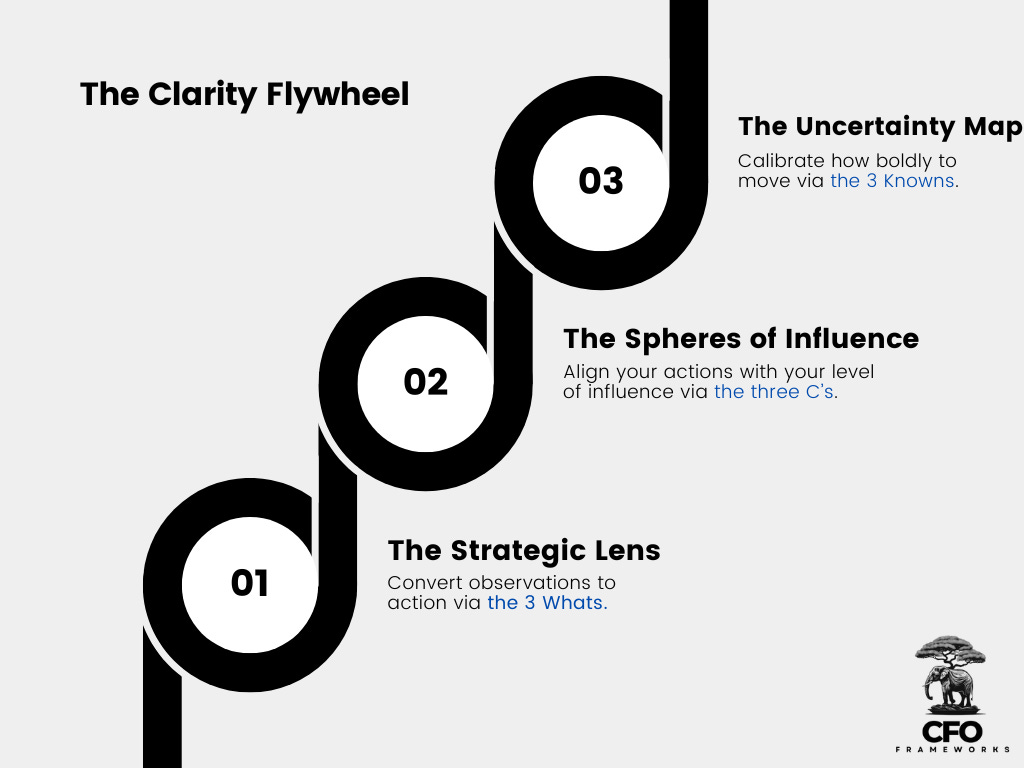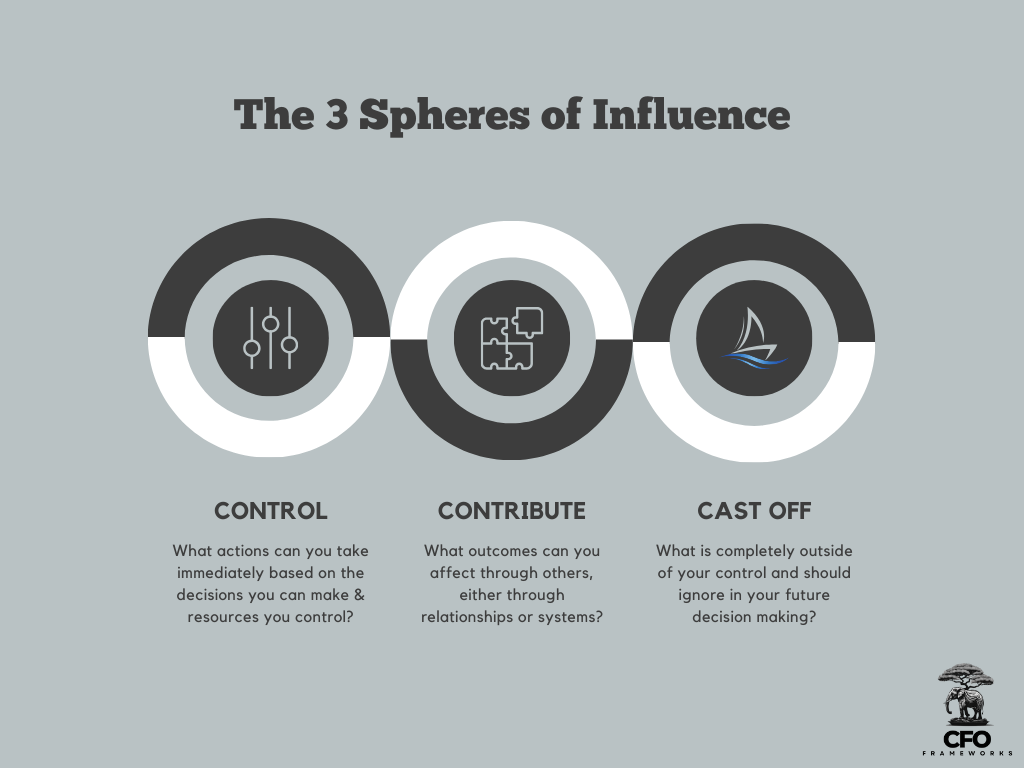Clear Thinking Under Pressure: 3 Tools That Transform Chaos Into Action
How to Build Your Clarity Flywheel for High-Stakes Decisions
In December 1914, Ernest Shackleton faced a leader's nightmare. His ship Endurance was trapped in Antarctic pack ice, slowly being crushed. Twenty-seven men stranded. No radio. No rescue coming. Just vast ice fields stretching to every horizon, with temperatures plunging below -20°F.
For many leaders, such chaos would have meant paralysis. But Shackleton did something remarkable: He turned clarity into momentum. First, he gathered unvarnished facts: 1,200 miles from safety, six months of food, and zero chance of rescue. This clear sight led to focused action: salvaging supplies, building ice camps, and maintaining morale. Each move revealed new possibilities, and each success built confidence until they had enough momentum to attempt what seemed impossible: a journey across 800 miles of the world's most treacherous seas.
Through seventeen months of relentless effort, this momentum carried every single crew member to safety. They survived brutal storms, navigated treacherous seas, and crossed unmapped mountains. But more remarkably, they proved something vital about leadership: clarity, properly applied, creates unstoppable momentum.
While few of us will face Antarctic challenges, we all encounter moments that demand this same transformation of clarity into momentum. Whether navigating a career transition, leading through change, or launching a venture, the fundamental question remains: How do you turn clear sight into unstoppable progress?
The answer lies in three frameworks that work together as a momentum-building system. Think of them as both navigation tools and parts of a powerful flywheel:
The Strategic Lens converts observation into action.
The Sphere of Influence aligns action with your level of influence.
The Uncertainty Map guides you on how confidently to advance.
These frameworks serve two vital functions:
As individual frameworks, they help you move skillfully through uncertain territory.
As a flywheel, they generate momentum that makes each turn more potent than the last.
Like a physical flywheel, this system takes initial effort to start turning. But once in motion, it creates compound benefits:
Clear sight reveals where to focus
Focused action expands your influence
Smart navigation reveals new opportunities
Each turn builds momentum for the next
Let's start with your first push: seeing reality with absolute clarity. This initial framework—which Shackleton used on the ice—converts raw observation into actionable insight.
1. The Strategic Lens - Seeing Reality Without Filters via the 3 What’s
When chaos strikes, our instinct is to act immediately. This is what makes Shackleton's first moments on the ice remarkable—instead of rushing to action, he forced himself to see the situation exactly as it was, not as he wished it to be.
The Strategic Lens framework builds this discipline into three deceptively simple questions (the 3 What’s):
While straightforward on the surface, answering them with candor often requires pushing past our natural biases and defense mechanisms. Further, it requires us to push beyond what feels like a natural finish line - explaining what happened - to convert it into a compensating response.
Key Principles
Ruthlessly separate facts from interpretations—be skeptical of answers that begin with “I think,” “I assume,” or “I would expect.”
Question your assumptions, especially those that make you comfortable—many issues arise from systemic causes, not individual actions.
Let data, not hopes, drive decisions—not everything is measurable, but if we're willing to disaggregate our existing views, we tend to have more signals than we believe.
Focus your strategic response on the impact, not the problem—you don’t need to solve the challenge you identify in raw reality to improve things.
Establish feedback loops to assess your understanding—your initial analysis of the situation may change as more information becomes available!
The power of this framework lies in its bias to action. Success arises from the courage to recognize reality instead of holding onto what we hope is true, prioritizing the construction of a future over the chronicling of the past.
2: Spheres of Influence - Focus Your Energy via the 3 C’s
Understanding reality is crucial, but it can also be paralyzing. When Shackleton assessed his situation on the ice, he saw dozens of problems: food shortages, crew morale issues, weather conditions, and navigation challenges. The key to his success wasn't just seeing clearly—it was knowing where and how to exert influence effectively.
This second framework helps you avoid two common traps:
Overreaching where you lack influence
Underutilizing the influence you have
Think of your influence extending across three distinct but interconnected spheres (the 3 C’s):
Key Principles
Start with what's directly within your control—when everything feels overwhelming, the smallest action within your control can create momentum.
Build influence through demonstrated competence—your sphere of influence grows naturally when you execute well in your control zone.
Let go strategically, not in defeat—releasing what you can't control isn't surrender; it's a deliberate choice to focus your energy where it matters.
Treat your spheres as dynamic, not fixed—what you can't influence today might become controllable tomorrow, and vice versa.
Focus on leverage points, not complete solutions—small actions in the right places often have more impact than grand gestures in the wrong ones.
The power of this framework lies not in controlling everything but in understanding where and how to apply influence effectively. Success often comes from knowing which sphere you're operating in and choosing the right approach for each.
3: The Uncertainty Map - Navigating via the 3 Knowns
After Shackleton assessed his situation and focused his energy, he faced the navigator's eternal question: How do we move forward when we can't see the whole path? Like any skilled explorer, he knew different territories demanded different approaches. You sprint across the open ground but move cautiously through the fog.
The Uncertainty Map is your navigation tool for unknown territory. Just as a physical map helps you choose your path and pace, this framework helps you:
Know where you stand (What territory are you in?)
Choose your approach (How should you move here?)
Spot the dangers and opportunities ahead
Adjust your speed and commitment to match the terrain
Key Principles
Build from what you know for certain—verified facts create a foundation for exploring unknowns.
Convert unknowns into experiments where possible—many "uncertainties" can be tested with small, low-risk actions.
Distinguish between what you can't know yet and what you can't know at all—timing might be uncertain, but underlying patterns rarely are.
Use uncertainty as a guide, not a barrier—gaps in knowledge often point to your next strategic opportunity.
Update your map as territories shift—what was unknowable yesterday might be explorable today.
The strength of this framework lies not in removing uncertainty but in navigating it wisely. Success is achieved by engaging with the unknown rather than being immobilized by it, transforming uncertainty from an obstacle into a guide.
The Clarity Flywheel: Where the Magic Happens
The real power of these frameworks emerges when they work together. Like a flywheel in engineering, the system gains momentum with each turn: facts revealed through your Uncertainty Map strengthen your Strategic Lens, influence gained through focused action expands your Sphere, and clarity about what you can control helps you navigate uncertainty more confidently.
Let's see how this cycle created unstoppable progress in one of history's greatest survival stories.
The Flywheel in Action: Shackleton's Journey
The power of the Clarity Flywheel becomes evident when we trace how Shackleton used all three frameworks in sequence, with each turn building on the last:
First Turn: Initial Crisis (January 1915)
When the Endurance first became trapped, Shackleton immediately began collecting hard data. Through careful celestial navigation, he fixed their position at 69°5'S, 51°30'W. He established a rigorous system of ice observations and supply inventories, creating a clear picture of their situation. This raw data (Strategic Lens) guided his first critical decisions about transforming the ship into a winter station.
With this clarity, he focused his influence where it mattered most: the ship's immediate operation. He reorganized the crew into a three-watch system, maintaining the discipline of a working vessel despite their immobility. Every man had duties, from meteorological observations to caring for the dogs, creating a sphere of productive activity within their ice-locked world.
Most importantly, Shackleton began methodically tracking what they could and couldn't know. While they could measure the ice's thickness and monitor its pressure on the ship, the duration of their entrapment remained unknowable. This acceptance of uncertainty helped him prepare the crew for a long wait while avoiding false promises about quick escape.
Second Turn: Ship's Abandonment (October 1915)
By October, new facts demanded attention. The ship's timbers were cracking under increasing ice pressure, and their position had shifted significantly with the drifting pack ice. Shackleton's careful observations showed the Endurance was doomed, leading to his order to abandon ship on October 27th.
This brutal reality clarified his sphere of control: they needed to create a viable camp on the ice. He focused the crew's energy on salvaging every useful item from the ship—from food stores to planks that could shelter their supplies. The organized routines established during their months on the ship proved crucial, as the crew efficiently transformed their situation from ship-based to camp-based survival.
Their uncertainty map evolved too. While they now knew with certainty they would need to escape by other means, they could begin exploring the movement patterns of the ice floe that became their home. This knowledge would prove crucial in the months ahead.
Third Turn: Escape Planning (April 1916)
After months of careful observation, Shackleton had accumulated crucial data about their drift and the changing ice conditions. Through regular navigation checks, he knew they had moved hundreds of miles north with the current. The warming spring temperatures were beginning to break up the pack ice—both an opportunity and a threat.
His sphere of influence now focused intensely on preparing for their escape by sea. Every man was assigned to specific boats, and they practiced launching procedures and emergency protocols. The crews were carefully balanced, with the most experienced sailors distributed among the three boats.
Their uncertainty map had evolved significantly. While they knew their position and had good data about prevailing currents, the conditions they would face in the open ocean remained unknown. Shackleton used this knowledge to make his boldest decision: rather than attempting to reach the closer but desolate Antarctic continent, they would aim for the whaling stations of South Georgia, where help was certain if they could reach it.
Each turn of the flywheel had built upon the last, transforming overwhelming chaos into actionable decisions. The frameworks didn't eliminate the danger—the most harrowing part of their journey still lay ahead—but they provided a method for moving forward when the situation seemed impossible.
Your Turn: Start Your Flywheel
Theory becomes powerful when put into practice. Here's how to begin:
The 90-Minute Clarity Sprint
Block out 90 uninterrupted minutes with a blank notebook and your most pressing challenge in mind.
First 30: Strategic Lens
List 10 pure facts about your situation
Challenge each: "How do I know this is true?"
Circle the 3 most surprising facts
Next 30: Sphere of Influence
Draw your three circles
Map what you control, what you can influence, and what to release
Choose one high-leverage action from your control zone
Final 30: Uncertainty Map
Note 3 certainties you can build upon
Identify 2 unknowns you could investigate this week
Spot 1 opportunity worth exploring
Maintain Momentum
Schedule two weekly check-ins:
Monday (15min): Choose one action and one uncertainty to investigate
Thursday (15min): Review what you learned and plan your next move
Avoid Common Traps
Don't wait for perfect information—start with what you know
Focus on what you can influence now, not everything that needs fixing
Turn unknowns into experiments rather than obstacles
Your First Turn
Every unstoppable force starts with a single push:
Your momentum begins with 90 minutes this week.
Not with solving everything.
Not with perfect clarity.
Just 90 minutes of honest observation, focused action, and intelligent navigation.
Book that time now. Create your space. Gather your tools. Give yourself the gift of momentum.
Remember:
The first turn is the hardest
Each turn makes the next one easier
Momentum, once built, becomes unstoppable
The leaders we admire aren't smarter or braver.
They've just learned to turn clarity into momentum.
Now it's your turn.
Your flywheel awaits. Time to push.







